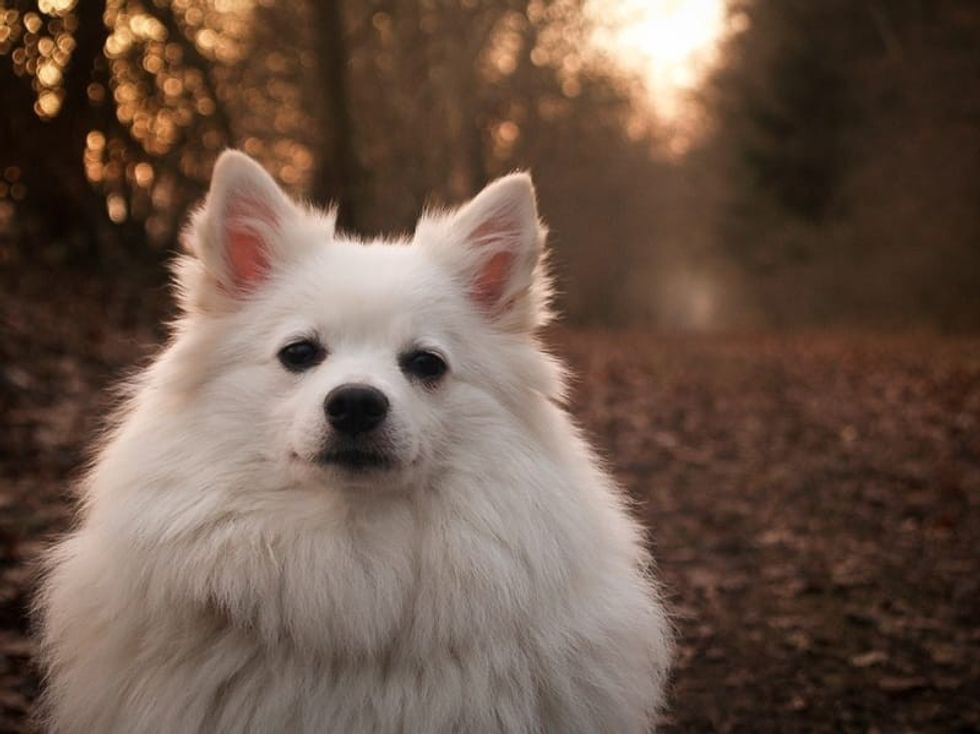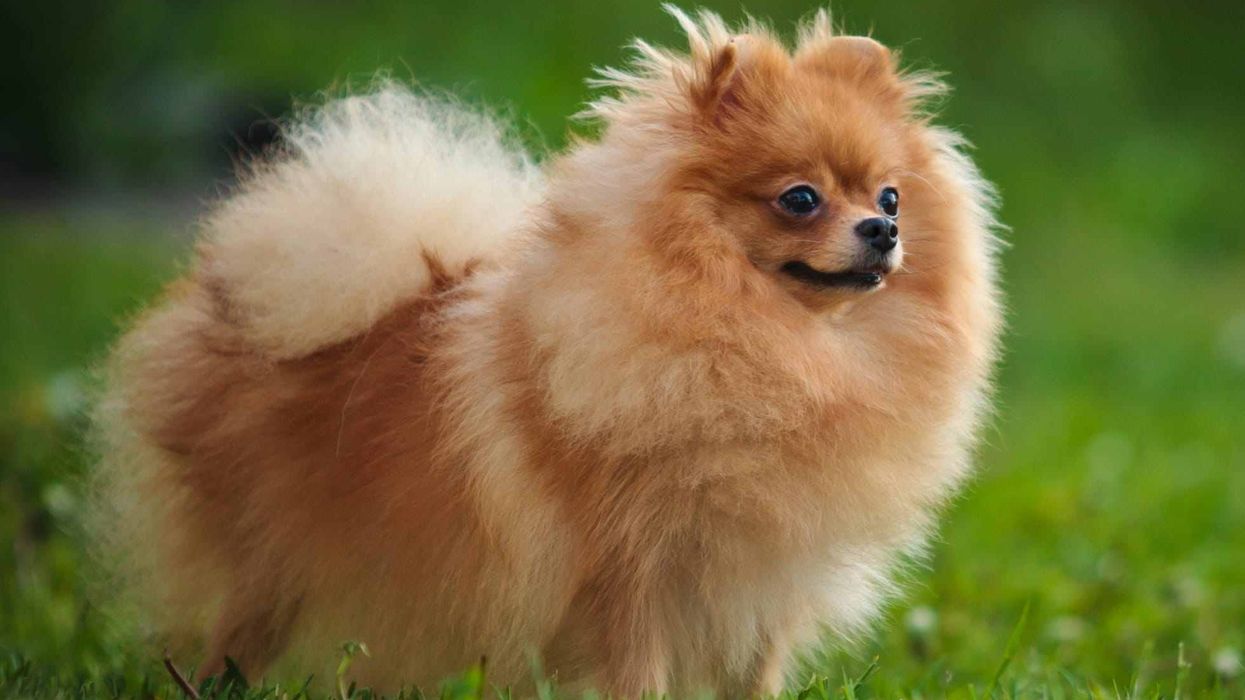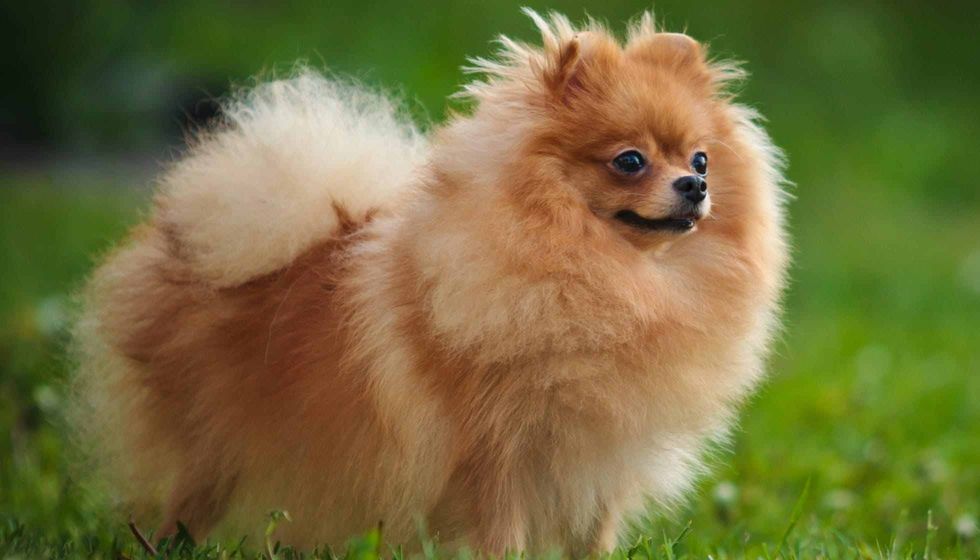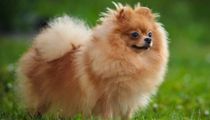Fun German Spitz Facts For Kids

Content
- What type of animal is a German Spitz?
- What class of animal does a German Spitz belong to?
- How many German Spitzes are there in the world?
- Where does a German Spitz live?
- What is a German Spitz's habitat?
- Who do German Spitzes live with?
- How long does a German Spitz live?
- How do they reproduce?
- What is their conservation status?
- What do German Spitzes look like?
- How cute are they?
- How do they communicate?
- How big is a German Spitz?
- How fast can a German Spitz run?
- How much does a German Spitz weigh?
- What are the male and female names of the species?
- What would you call a baby German Spitz?
- What do they eat?
- Are they slobbery?
- Would they make a good pet?
- Did you know...
- Characteristics and health issues
- Getting your own German Spitz
The German Spitz is a small dog of the spitz variety with German origins. They are one of the oldest dog breeds from central Europe.
It became popular in 1450 after Count Eberhard Zu Sayn praised them for being a good defender of fields and homes. Many ancestors of this breed emerged in the Pomeranian Province located between modern-day Poland and Germany. Based on color and size, there are five more varieties of this breed.
Their coat comes in a variety of colors like chocolate brown, tan, white, cream, gold, and black. They have beautiful thick tops and undercoats. It is necessary to feed them good quality food throughout their growing phase.
They are often confused with the Pomeranians. They are active and high-alert dogs.
For this very reason, they were watchdogs on farms and boats as peasant dogs back in the day. They are known as 'mistbeller' meaning 'dung-hill barkers' in Germany.
In the 19th century, the royalty and upper class took an interest in this breed and it became more popular. There was a drastic decline in the population of German spitz during World War I, but later, in 1875, many were imported and bred. Read on to find out more!
If you find the facts about German Spitz interesting, you may also read Cairn terrier and bull terrier facts.
German Spitz Interesting Facts
What type of animal is a German Spitz?
The German Spitz is a medium-sized dog of the Canidae family. They are one of the toy breeds. They are primarily kept on land for guarding and herding, due to which they show a high prey drive. They are descendants of herding dogs from Nordic.
This spitz is a family dog. This German spitz dog has eventually become smaller, and it is now a companion dog. These species are also related to Swedish, Samoyed, and Finnish Lapphund. They are often confused with Pomeranian.
What class of animal does a German Spitz belong to?
The German Spitz is of class mammal of animals.
How many German Spitzes are there in the world?
Several spitz dog species get exported and bred around the world. So, the exact number of German Spitz is unknown.
Where does a German Spitz live?
The German spitz dog breed is bred as a companion dog. So, they'll do very well among humans and other pets when trained.
What is a German Spitz's habitat?
The German Spitz dogs do very well with humans and as apartment dogs. It is not a necessity to have a yard. The German spitz temperament is dominating and at times will continuously bark. These behaviors can be kept at bay with proper training and exercise. They also love walks.
Who do German Spitzes live with?
The German spitz lives with humans. They can also be kept with other pets if they are introduced to other pets when they are puppies.
How long does a German Spitz live?
The German spitz lifespan is around 12-15 years. In stress-free and generally healthy environments, they can live up to 17-18 years.
How do they reproduce?
The German spitz pregnancy lasts up to 60-64 days. The female goes through four stages of the reproductive cycle. The duration between each mating season is about six months. The first stage is called Proestrus, which lasts for nine days.
In this stage, the females attract the males. The signs are the swelling vulva and bloody discharge. The second stage which lasts for 3-11 days is called Estrus, and the female is now receptive to a male spitz.
During this stage, the discharge reduces and lightens in color. The third stage starts on day 14, and the female will not permit mating after this stage. The discharge stops. The last stage is called Anestrus.
What is their conservation status?
The conservation status of the German spitz is the Least Concern. Even though they were threatened during World War I, they have made a strong comeback. Health problems faced by the toy spitz are luxating patella, dental problems, and progressive retinal atrophy.
German Spitz Fun Facts
What do German Spitzes look like?
Also known as Deutscher Spitz, this breed of Spitz has a soft and straight double coat and long hair. The size and color of this dog species vary with each variety. The inner layer of the coat is short, soft, and thick.
The outer coat, however, is rough and relatively long. The medium-sized head resembles a fox head, and their eyes are alert. The German spitz dogs have small and pointed ears with a small gap between them. The eyes are almond-shaped and medium-sized.
The nose is black and small. The collar is robust and mane-like. They have bushy tails carried over their backs.
The German Spitz breed is as long as they are tall. The hindquarters are muscled and feathered. They have good leg bone strength. The forequarters are straight and broad.
The shoulders are well-developed and muscled. The Giant Spitz is usually black, white, and brown. The medium and miniature-sized Spitz has a coat color from black and white to gray and orange.

How cute are they?
We think they are very cute. As the name suggests the toy spitz is fluffy with two layers of coat and is a beautiful dog.
How do they communicate?
The German spitz mainly communicates with their bark to alert their owners of any movement. These dog breeds have great eyesight and chase drive. They also use their smell. Some reasons for barking are boredom, fear, greeting, alerting, anxiety, and many more.
How big is a German Spitz?
The length of a German spitz is 17-18 in (43-45.7 cm). The height of male and female German spitz differs only by a few inches. The female is 15-19 in (38-48 cm) and the male is 19-23 in (48-58 cm) tall.
How fast can a German Spitz run?
The German spitz is a fast runner. The data on their speed is unavailable.
How much does a German Spitz weigh?
The male and female German spitz also differ in weight. The female German spitz weight is 18-27 lb (8-12 kg) and the male weight is 24-33 lb (11-15 kg). The average male weight is 28.5 lb (13 kg) and the average female weight is 22.5 lb (10 kg).
What are the male and female names of the species?
There are no specific names given to the male and female German spitz dogs.
What would you call a baby German Spitz?
The baby German Spitz breed is usually referred to as a German Spitz puppy.
What do they eat?
The diet of German spitz puppies and adults differs. These small breed dogs should be fed a high-quality and high-energy diet. The German spitz's feeding schedules need to be regular and try to avoid leaving food out during the day.
This can cause obesity. It is also necessary to consult a veterinarian about diet as it varies from size to breed type. You can also mix canned food, broth, or water with dry food for adults.
They can also be fed fruits, vegetables, cooked eggs, and cottage cheese in limit. It should be way less than their daily food. Provide fresh and clean water.
A German Spitz puppy needs four meals when 8-12 weeks old. When they are 3-6 months feed them three meals. Gradually reduce the quantity as they grow old. These small breeds might need an extra meal when they exercise a little more than required.
Are they slobbery?
No. The German spitz is not slobbery. These small dogs have a low tendency of drooling. Drooling can also be a cause of underlying illness and should be contacted by the veterinarian as soon as possible.
Would they make a good pet?
Yes. The German Spitz would make a great pet. The German Spitz was primarily bred as companion dogs.
They love to play with you and so do not enjoy being left alone for long. This spitz German dog breed is active and has high trainability. The German Spitz needs high grooming.
They do need hair trimming. Regular brushing of the dog coat reduces shedding, but with both coats of fur, they are not hypoallergenic dogs. The Deutscher spitz breeds do not face serious health issues.
These dogs are very bright, and that makes it easy to train them to memorize commands. The German Spitz has high sensitivity level and does not like noisy environments, irregular routines, and frequent house guests. This breed is obedient to family members, and it takes little effort in training them.
The training process should be consistent. When the training starts early, they are less stubborn than when they are old. They will learn to pay attention and develop good habits.
Without regular exercise and training, they will demand the owners and will not listen. They do not do well with punishments and they prefer positive association and reinforcement. They make good companions to elderly people.
Did you know...
The word Spitz means 'pointed' in German.
The National History of Quadrupeds, written by Count Eberhard Zu Sayre Buffon in 1750, mentions that the ancestors of all German dog breeds are spitz dog breeds.
The American Eskimo dog has its origins in the German spitz breed. The American Kennel Club officially recognized the American Eskimo dog in the year 1919.
These German Breeds are great swimmers.
If trained to socialize as a puppy, they can get along confidently with other breeds in a large pack. It will also avoid aggression towards strangers and other animals.
They are known to be great singers. As they are very vocal, they howl and make noises with the music. The Spitz dog's favorite instrument is the harmonica.
It was in the year 2003 that the first litter of German Spitz was born in America. The United States has been importing these breeds since then from Australia and the United Kingdom.
The puppy Spitz should be picked up, with one hand on their chest and the other supporting their hind legs. Never pick them up by their tail, back of the neck, or forequarters.
This breed of Spitz is considered one of the oldest species from central Europe in the world. They are the predecessors to several current dog species like American Eskimo, Eurasier, and Japanese Spitz.
Even though sometimes they tend to chase away small animals, they do not have too high a prey drive. They do not have much of a hunting instinct when compared to other breeds.
A good choice for first-time owners is a German Spitz Klien or Miittel, and training and socializing are necessary.
Two countries to first recognize these breeds were Great Britain and Scandinavia.
Characteristics and health issues
There are five more similar breed varieties of the German Spitz mix. The Dwarf Spitz Pomeranian breed has an orange, white, black, brown, and gray-colored coat. The Pomeranian is a small-sized breed.
They weigh 3.1-6.6 lb (1.4-3 kg) and are 7.1-9.4 in (18-24 cm) tall. The Wolfsspitz or Keeshond dogs are gray-colored and medium-sized breeds.
They weigh 55-66 lb (25-30 kg) and are 17-22 in (43-55 cm) tall. The Giant Spitz has a black, white, or brown-colored coat with white spots on the paws, chest, or tails. This breed is medium-sized.
They weigh 34-40 lb (17-18 kg )and are 17-22 in (43-55cm) tall. The Medium Spitz is a medium-sized breed with a brown, black, white, gray, or orange-colored coat.
They weigh 23-25 lb (10.5-11.5 kg) and are 12-16 in (30-40 cm) tall. The Miniature spitz also has the same coat colors as the medium spitz but is small-sized. They weigh 18-22 lb (8-10 kg) and are 9.4-11.8 in (24-30 cm) tall.
The German spitz is a healthy breed. This dog does not face serious health issues. However, there's a high potential to sustain genetic disorders. Some health issues of this dog include:
Idiopathic Epilepsy. The primary symptom of this health issue is sudden seizures. If ignored, these seizures make your pet very weak within just three weeks.
Cataract. This health issue is a usual eye disease in the German Spitz. The chances of getting this problem increase with age. The primary symptoms of this issue in a dog are blurred vision and coordination.
Patellar luxation. When the knee of a dog dislodges from its place, it is called patellar luxation. The symptoms of this issue in a dog are painful lameness and the problem with the dog's movement.
The spitz German dog breed is also prone to health problems such as autoimmune disorders and hip dysplasia. Obesity in dogs causes diabetes.
Getting your own German Spitz
The German spitz costs around $ 800-1000. This small Deutscher spitz is a companion breed, loyal, family-friendly dog. The German Spitz is a high-energy level dog and is easy to train. These dogs very well in an apartment.
It is necessary to be alert around the dogs. Elevators and balconies can be dangerous at times. While waiting for an elevator, be aware of your dog's movements. It is best to have childproof balconies to avoid accidents.
While adopting or buying this dog, make sure to ask for the necessary certificates from the breeder. Meet the puppy in person before getting them home.
It will draw a picture of the type of environment they are growing in, and you can look elsewhere if they seem aggressive. Make sure to ask for information about the direct bloodline. It is necessary to find out if the pup has any genetic disorders from their parents.
Professional breeders always conduct medical exams and vaccinate puppies. So, check the medical reports for any illness.
Here at Kidadl, we have carefully created lots of interesting family-friendly animal facts for everyone to discover! Learn more about some other mammals including American pit bull terriers or border terriers.
You can even occupy yourself at home by drawing one on our German spitz coloring pages.
We Want Your Photos!
More for You
Sources
https://dogtime.com/dog-breeds/german-spitz#/slide/1
https://www.akc.org/dog-breeds/german-spitz/
https://www.k9web.com/breeds/german-spitz/
https://www.dimensions.com/element/german-spitz-mittel
https://www.petguide.com/breeds/dog/german-spitz-klein/
https://www.dogbreedinfo.com/g/germanspitzgiant.htm
https://www.dogbreedinfo.com/g/germanspitzsmall.htm
https://en.wikipedia.org/wiki/German_Spitz
See All
Bachelor of Engineering specializing in Aeronautical/Aerospace Technology, Master of Business Administration specializing in Management

Arpitha RajendraBachelor of Engineering specializing in Aeronautical/Aerospace Technology, Master of Business Administration specializing in Management
With a background in Aeronautical Engineering and practical experience in various technical areas, Arpitha is a valuable member of the Kidadl content writing team. She did her Bachelor's degree in Engineering, specializing in Aeronautical Engineering, at Nitte Meenakshi Institute of Technology in 2020. Arpitha has honed her skills through her work with leading companies in Bangalore, where she contributed to several noteworthy projects, including the development of high-performance aircraft using morphing technology and the analysis of crack propagation using Abaqus XFEM.
Bachelor of Technology specializing in Information Technology

Smriti ChaudharyBachelor of Technology specializing in Information Technology
Smriti, a student data scientist, and coder, is pursuing her Bachelor of Technology at K.J. Somaiya College of Engineering. She has achieved top rankings in the International English Olympiad, National Spelling Bee, and PSAT/SAT English Section. She is experienced in content creation and editing for various academic institutions.
Disclaimer
1) Kidadl is independent and to make our service free to you the reader we are supported by advertising. We hope you love our recommendations for products and services! What we suggest is selected independently by the Kidadl team. If you purchase using the Buy Now button we may earn a small commission. This does not influence our choices. Prices are correct and items are available at the time the article was published but we cannot guarantee that on the time of reading. Please note that Kidadl is a participant in the Amazon Services LLC Associates Program, an affiliate advertising program designed to provide a means for sites to earn advertising fees by advertising and linking to Amazon. We also link to other websites, but are not responsible for their content.
2) At Kidadl, we strive to recommend the very best activities and events. We will always aim to give you accurate information at the date of publication - however, information does change, so it’s important you do your own research, double-check and make the decision that is right for your family. We recognise that not all activities and ideas are appropriate for all children and families or in all circumstances. Our recommended activities are based on age but these are a guide. We recommend that these ideas are used as inspiration, that ideas are undertaken with appropriate adult supervision, and that each adult uses their own discretion and knowledge of their children to consider the safety and suitability. Kidadl cannot accept liability for the execution of these ideas, and parental supervision is advised at all times, as safety is paramount. Anyone using the information provided by Kidadl does so at their own risk and we can not accept liability if things go wrong.
3) Because we are an educational resource, we have quotes and facts about a range of historical and modern figures. We do not endorse the actions of or rhetoric of all the people included in these collections, but we think they are important for growing minds to learn about under the guidance of parents or guardians.







